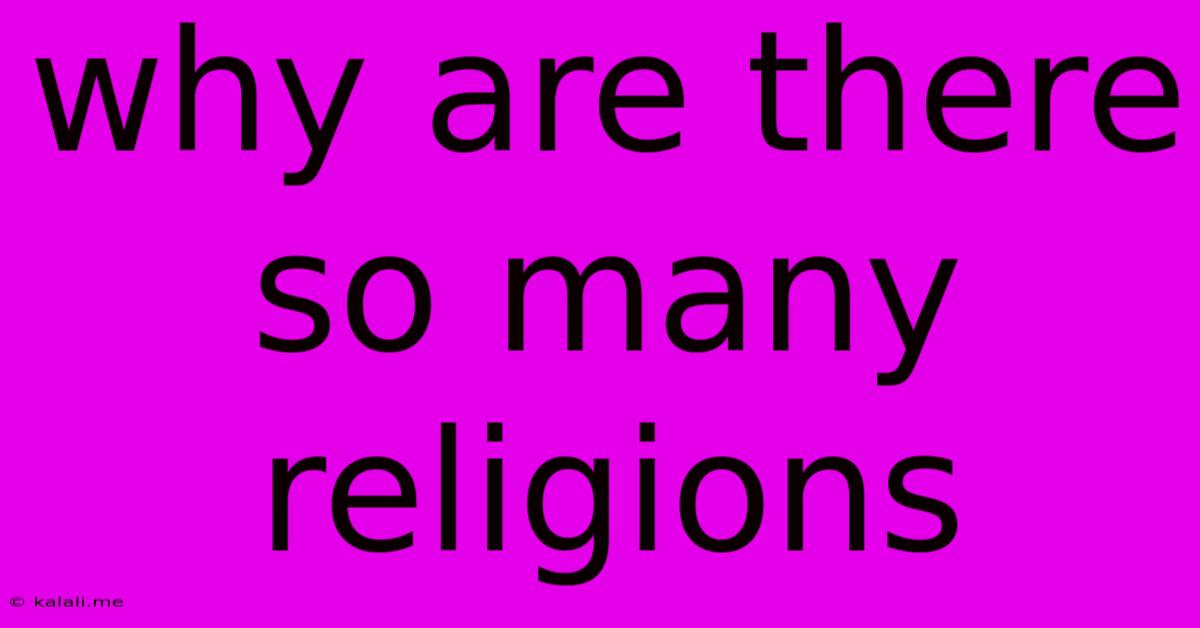Why Are There So Many Religions
Kalali
Jun 10, 2025 · 3 min read

Table of Contents
Why Are There So Many Religions? A Journey Through Belief Systems
The sheer diversity of religious belief systems across the globe is a captivating and complex phenomenon. From the ancient traditions of Hinduism and Buddhism to the relatively modern rise of Pentecostalism, the world is a tapestry woven with countless faiths, each with its unique rituals, doctrines, and interpretations of the divine. But why? Why are there so many religions, and what factors contribute to this incredible variety? This article delves into the historical, sociological, and psychological reasons behind this fascinating global phenomenon.
The question of religious diversity is not easily answered with a single explanation. Instead, a multitude of intertwining factors have shaped the religious landscape we see today. Understanding these factors provides a nuanced perspective on the existence of numerous faith traditions.
Historical and Geographical Influences: The Seeds of Diversity
Geographical isolation and the independent development of early human societies played a significant role. Different communities, separated by vast distances and geographical barriers, developed their own unique belief systems to explain the world around them. These early beliefs, often rooted in animism, ancestor worship, and the observation of natural phenomena, formed the foundation for many of the world's major religions. The evolution of these beliefs over centuries, influenced by contact with other cultures and the rise of powerful empires, led to the diversification and spread of religious ideas. Consider the impact of trade routes, migrations, and conquests in disseminating religious concepts across vast swathes of territory.
Sociological Factors: Adapting to Context
Religion often serves as a powerful social glue, binding communities together and providing a shared sense of identity. As societies evolved, so did their religious beliefs. New religions emerged to address the changing needs and social structures of their adherents. The rise of urbanization, the development of complex political systems, and the challenges of a rapidly changing world all contributed to the creation of new religious expressions and the reformulation of existing ones. The adaptation of religious practices and beliefs to specific social and cultural contexts – a process often referred to as syncretism – is a major driver of religious diversity. We see examples of this throughout history, with new faiths often blending elements from pre-existing belief systems.
Psychological Factors: The Human Need for Meaning and Purpose
The human desire for meaning, purpose, and connection to something larger than oneself is a fundamental aspect of the human condition. Religion provides a framework for understanding existence, coping with suffering, and finding hope in the face of adversity. Different individuals and communities find solace and fulfillment in different religious frameworks. This inherent human need for meaning explains, in part, the persistent appeal of religious belief across cultures and throughout history. The diversity in religious expression reflects the multifaceted nature of human experience and the varied ways in which individuals seek to make sense of the world.
Political and Power Dynamics: Religion as a Tool
The role of politics and power in shaping religious landscapes cannot be ignored. The rise and fall of empires, the actions of religious leaders, and the political manipulation of religious beliefs have all profoundly impacted religious diversity. The persecution of certain religious groups and the patronage of others have dramatically shaped religious demographics across various historical periods. Competition for followers and influence has also played a significant role in the fracturing of religious movements into distinct denominations and sects.
In Conclusion: A Tapestry of Belief
The multitude of religions across the globe is not simply a matter of chance but a product of intricate historical, sociological, and psychological processes. The interplay of these factors has produced a rich tapestry of belief systems, each reflecting the unique experiences and aspirations of its adherents. Understanding these complexities helps us appreciate the enduring power of religious belief and the fascinating diversity of the human experience. The existence of so many religions is a testament to the enduring human search for meaning, purpose, and connection in a complex and ever-changing world.
Latest Posts
Latest Posts
-
How To Remove Glue From Cement
Jun 11, 2025
-
Can A Non Jew Attend Synagogue
Jun 11, 2025
-
Converting Truss Attic To Living Space
Jun 11, 2025
-
Can You Tranfer Items In Monster Hunter World
Jun 11, 2025
-
How Many Years Between Abraham To Jesus
Jun 11, 2025
Related Post
Thank you for visiting our website which covers about Why Are There So Many Religions . We hope the information provided has been useful to you. Feel free to contact us if you have any questions or need further assistance. See you next time and don't miss to bookmark.